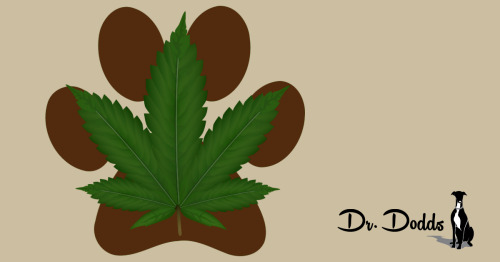Medicinally Active Native Plants: The use of cannabis for pets

Did you know that approximately 40% of the United States pharmaceutical drugs are derived from plants? Many rainforest and other native plants have potent and useful medicinal properties, and some are controversial, misunderstood or abused.
Good examples are heroin, an illegal drug, and Vicodin, a commonly prescribed pain reliever. Both are derivatives of opium. Opium has five active ingredients: morphine, codeine, thebaine, papaverine and noscapine. Heroin comes from morphine, while Vicodin is formed using codeine. Opium – like all things – is a yin-yang situation: for pain relief but is fairly addictive.
When you read heroin, opium and Vicodin, you probably had
different visceral reactions to each. Historical events have shaped societal
and cultural perceptions and your subsequent reactions. It is ironic to think
that opium – a much more potent plant than cannabis and more divisive
historically – is still used widely for its therapeutic properties in prescription
drugs. Yet, the use of cannabis is exceedingly more controversial.
Cannabis the Weed
Cannabis is actually categorized as a weed. Similar to apples and lilies, different varietals exist. Some varietals have high concentrations of tetrahydrocannabinol (THC) and others have concentrations of cannabidiol (CBD). THC is what causes a person to become stoned or high. THC has medicinal properties but the two current and major manufacturers of cannabis for pets use the hemp variety, which has higher concentrations of CBD. For the purpose of this article, we will focus on CBD.
According to a British review published in 2013, CBD has the following benefits.
Antiemetic (motion sickness – Reduces nausea and vomiting
Anticonvulsant – Suppresses seizure activity
Antipsychotic – Combats psychosis disorders
Anti-inflammatory – Combats inflammatory disorders
Antioxidant – Combats neurodegenerative disorders
Anti-tumoral/Anti-cancer – Combats tumor and cancer cells
Anxiolytic/Anti-depressant – Combats anxiety and depression disorders
It should be noted that research has not been completed yet
to show if it CBD is a preventative. So, please don’t
use it to prevent conditions yet.
How CBD Works
Mammals have naturally occurring molecules dubbed
“endocannabinoids”, which are similar to the active compounds in marijuana. Both
bind to proteins called cannabinoid receptors that promote homeostasis at all
levels in the body. So, the endogenous cannabinoid system influences our immune
system, protects nerve cells from premature death, and influences mood, memory,
appetite, sleep, sensation, and movement. When the system is malfunctioning it
is perpetuating or influencing one of several conditions in which it is
supposed to protect against. CBD from cannabis can, in turn, signal the body to
make more endocannabinoids and build more cannabinoid receptors.
CBD in Action
Phenobarbital is a potent anticonvulsant commonly prescribed to humans and pets to reduce seizure propensity. It is processed through the liver and can have adverse effects on liver enzymes and cause liver damage, but mostly in animals that are hypersensitive to this drug. Generally, it is quite safe if used judiciously. Studies on mice have shown that phenobarbital used in combination with cannabis can help reduce the dosage of phenobarbital and lower liver enzymes. Of course, the potential of adverse side effects are possible with these two used in combination. Overall, I recommend that everyone only administer cannabis under the guidance of a veterinarian.
W. Jean Dodds, DVM
Hemopet / NutriScan
11561 Salinaz Avenue
Garden Grove, CA 92843
References
“5 Must-Know Facts About Cannabidiol (CBD).” Leaf Science, 22 Feb. 2014. Web. 08 Nov. 2015. <http://www.leafscience.com/2014/02/23/5-must-know-facts-cannabidiol-cbd/>.
“7 Proven Medical Benefits of THC.” Leaf Science, 22 July 2014. Web. 08 Nov. 2015. <http://www.leafscience.com/2014/07/22/7-proven-medical-benefits-thc/>.
“Cannabis in the Clinic: The Medical Marijuana Debate." Learn.Genetics. Genetic Learning Center. University of Utah, n.d. Web. 08 Nov. 2015. <http://learn.genetics.utah.edu/content/addiction/cannabis/>.
Florek-Luszczki, Magdalena, Aleksandra Wlaz, Maria W. Kondrat-Wrobel, Piotr Tutka, and Jarogniew J. Luszczki. "Effects of WIN 55,212-2 (a Non-selective Cannabinoid CB1 and CB2 Receptor Agonist) on the Protective Action of Various Classical Antiepileptic Drugs in the Mouse 6 Hz Psychomotor Seizure Model." Springer Link. Journal of Neural Transmission, July 2014. Web. 08 Nov. 2015. <http://link.springer.com/article/10.1007%2Fs00702-014-1173-7>.
Kilham, Chris. "About Plant Medicines." About Plant Medicines. Medicine Hunter, n.d. Web. 08 Nov. 2015. <http://www.medicinehunter.com/about-plant-medicines#sthash.YB7dViLX.dpuf>.
"Medical Marijuana vs. Recreational: What’s The Difference?” Leaf Science, 04 Sept. 2014. Web. 08 Nov. 2015. <http://www.leafscience.com/2014/09/04/medical-marijuana-vs-recreational-whats-difference/>.
“Opium." Wikipedia. Wikimedia Foundation, n.d. Web. 08 Nov. 2015. <https://en.wikipedia.org/wiki/Opium>.
Serrano, Alfonso. "Weed All about It: The Origins of the Word ‘marijuana’.” Aljazeera America, 14 Dec. 2015. Web. 08 Nov. 2015. <http://america.aljazeera.com/articles/2013/12/14/weed-all-about-ittheoriginsofthewordamarijuanaaintheus.html>.
Sulak, Dustin, DO. “Introduction to the Endocannabinoid System.” NORML, n.d. Web. 08 Nov. 2015. <http://norml.org/library/item/introduction-to-the-endocannabinoid-system>.
Zimmermann, Kim Ann. “Medical Marijuana: Benefits, Risks & State Laws." LiveScience. TechMedia Network, 14 Jan. 2015. Web. 08 Nov. 2015. <http://www.livescience.com/24554-medical-marijuana.html>.
portableemil liked this
cuddlypetpics liked this
drjeandoddspethealthresource posted this